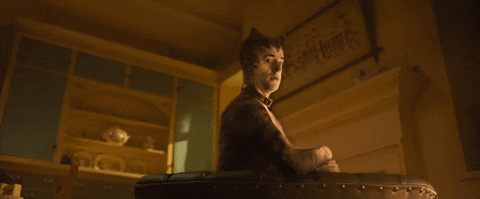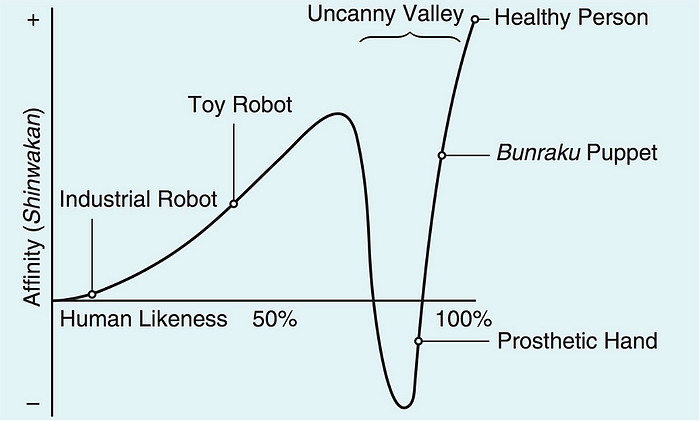Is an Anthropomorphic Cat Really an Anthropomorphic Cat?
Deconstructing Derrida’s theory of deconstruction through the scope of Cats (2019), humanoid robots, and the uncanny valley.

As the technology of computer-generated imagery evolves into more realistic and lifelike depictions, so too does the potential for the uncanny valley phenomena. Cats (2019) is a great example of the integration of motion capture technology to create what would be considered a rather lifelike representation of anthropomorphic cats. Unfortunately, that lifelike quality affected the reception of the final production.

The term ‘uncanny valley’ was first coined in the 1970s to describe the feeling of strangeness regarding lifelike humanoid robots (Caballar, 2019). Then professor, Masahiro Mori, describes his observations regarding these robots. He noticed that while they became more appealing, it was only until a certain point (ibid).
“Upon reaching the uncanny valley, our affinity descends into a feeling of strangeness, a sense of unease, and a tendency to be scared or freaked out. So, the uncanny valley can be defined as people’s negative reaction to certain lifelike robots” (ibid).

It’s this negative reaction audiences were feeling when first watching the trailer for Cats. While they may not understand the issues they’re having with the CGI, they were still blaming the visual effects. The combination of cat and human was too lifelike, which was heightened by the motion capture technology to use known celebrities to create the faces of the cats. The musical has been around since the 1980s, so we can rule out the idea of anthropomorphic cats as being the underlying issue. It’s simply the realism and the uncanny valley response audiences were having to this strange unknown.

Deconstruction occurs as we interact with chosen texts to interpret signs and meaning. We know something is a cat because we know it’s not a dog, not a human, not an inanimate object. Our brains deconstruct the sign based on our understanding of the world around us, eliminating options until we are content with the interpretation we have made. This is what Derrida theorised since the 70s, describing how meaning is created in relation to other words (Augustyn, 2020). Perhaps our minds become muddle and uncertain when we see humanoid characters and understand them to be ‘other,’ yet the physical appearance of the creation makes us question our own mind.
Another example of film technology confusing audiences’ perception of reality was seen in the test audience for Shrek (2001). The original design for Princess Fiona was much more realistic than the final product shows. The animation techniques used to create her made her appearance too close to the human being, which caused the children in the audience to be distress and therefore crying during the test screening (LaFrance, 2012).
While there are a plethora of Hollywood films pushing the limits of CGI to create outstanding products, there is still room for us as the audience to not fetishise CGI. Sure, we can learn to love blockbuster movies such as the new Star Wars films or the entirety of the Marvel Cinematic Universe, but we draw the line at close-to-perfect depictions of humans.
Arguably, the previous two examples have a clear purpose of not representing people as their true selves. Princess Fiona was for a children’s animated movie and the cast of Cats are, well, cats. But the appearance of the uncanny valley can still be seen in movies where characters are meant to exist as real humans amongst the rest of the cast available. Look at Carrie Fisher in Star Wars: The Rise of Skywalker (2019) where the visual effects team extracted Fisher’s face from unused footage and applied those elements onto a digital body (Eisenberg, 2020). While the product was believable to audiences, there was still a strange element to the features. One could say it’s the sense of unease the uncanny valley gives the audiences. A similar feat was achieved in Furious 7 (2015) with the sudden death of Paul Walker. Walker’s brother was used in the final scenes as the actor. The team from Weta Digital later applied unused footage of Walker onto his brother’s face and adjusted the lighting (Giardina, 2015). While the product isn’t as perfect as Fisher’s (which one could easily blame the advancement of technology used for Fisher versus Walker), it was still rather effective. But it was also still uncanny.
Sure, CGI is used to make the audiences sit in awe and the marvel that’s on the cinema screens, but it will never completely replace reality. Our brains are subconsciously deconstructing the text in front of us, telling us what we’re not seeing to help us contextualise the meaning. In doing so, we acknowledge we’re not seeing a real human when every other piece of information our brain is receiving is telling us it looks like a human. This sense of unease will mean it will take a rather long time for technology to advance in such a way for us to accept this as truth.
BIBLIOGRAPHY
Augustyn, A. (2020). deconstruction | Definition, Philosophy, Theory, Examples, & Facts. Retrieved 7 November 2020, from https://www.britannica.com/topic/deconstruction
Caballar, R. (2019). What Is the Uncanny Valley?. Retrieved 7 November 2020, from https://spectrum.ieee.org/automaton/robotics/humanoids/what-is-the-uncanny-valley
Eisenberg, E. (2020). Star Wars: The Rise Of Skywalker Put Carrie Fisher’s Face On A Digital Body To Bring Back Leia. Retrieved 7 November 2020, from https://www.cinemablend.com/news/2487902/star-wars-the-rise-of-skywalker-put-carrie-fishers-face-on-a-digital-body-to-bring-back-leia
Giardina, C. (2015). How ‘Furious 7’ Brought the Late Paul Walker Back to Life | Hollywood Reporter. Retrieved 7 November 2020, from https://www.hollywoodreporter.com/behind-screen/how-furious-7-brought-late-845763
LeFrance, C. (2012). By hand or on the computer? The threat of the Uncanny Valley. Retrieved 7 November 2020, from https://www.sessions.edu/notes-on-design/by-hand-or-on-the-computer-the-threat-of-the-uncanny-valley/#:~:text=The%20animated%20film%20Shrek%20initially,perfect%20that%20it%20was%20creepy.
Tayag, Y. (2019). ‘Cats’ Trailer: Uncanny Valley Researchers Explain Why It’s So Creepy. Retrieved 7 November 2020, from https://www.inverse.com/article/57870-cats-trailer-filmed-in-the-uncanny-valley
